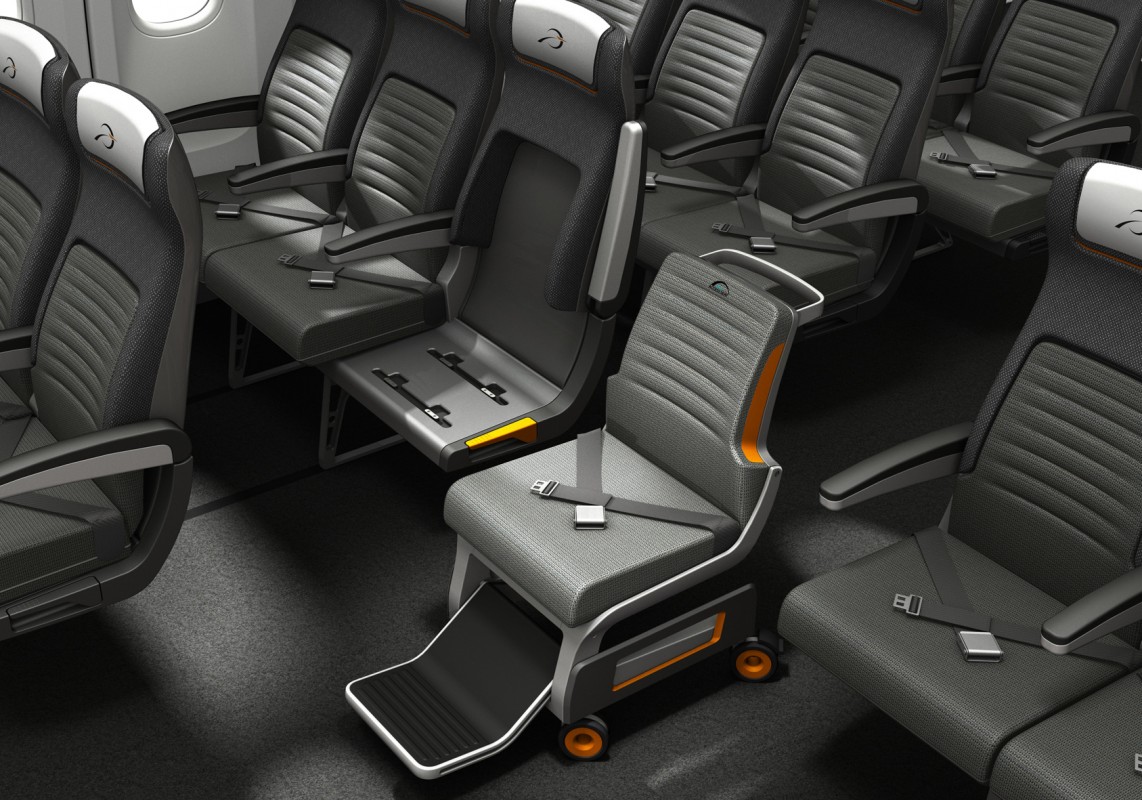Air Access. Air travel for all
Air Access. Air travel for all
Air Access is a concept that facilitates air travel for passengers with reduced mobility by enabling an easier transition from gate to aircraft. Air Access is a much needed concept for the future of air travel that aims to meet the needs of an increasingly older and less mobile population. The concept design aims to reduce the indignity and discrimination that passengers with reduced mobility face when travelling by air.
Paul Priestman, founding director of PriestmanGoode, explains: "We have been designing aircraft interiors for over fifteen years and always work to improve the entire passenger journey, from home to destination. At present there are some accessibility regulations on aircraft, however they cater for only the most basic requirements.As a result, passengers with special needs often face considerable difficulties when travelling by air."These difficulties generally go unnoticed" ? very few members of the public are aware of the anxiety and discomfort PRMs can experience when travelling. But it is a matter of equality that people with reduced mobility should have the same rights to a quality passenger experience that able-bodied people have." Priestman continues "As designers we strive to improve things, not just for the immediate future, but for the long-term.
A demographic shift is sweeping across Europe: the population is ageing, life expectancy is increasing, obesity levels are rising and PRMs account for a larger proportion of the population than ever before. Air Access is a much-needed concept for the future of airline travel that will provide a pleasant experience for passengers with disabilities or reduced mobility.
Why do we need Air Access?
Currently, around 20% of the adult population has some form of disability or mobile difficulty. For this demographic air travel can be fraught with problems. Ground and airline staff are often inadequately trained and unaware of their legal obligations. The absence of a systematic process for boarding and disembarking PRMs can lead to confusion and complications for airline staff.
For PRMs, being physically assisted into and out of airplane seats can be stressful and demeaning, and in-flight toileting can be difficult. It?s imperative that we start thinking today about implementing change to cater for future
generations of air travellers.
How it works
The Air Access concept consists of two elements: a detachable wheelchair by which passengers can be transported onto and off of the plane, and a fixed-frame aisle seat on the aircraft into which the wheelchair is mated to create a regular airline seat.
1. Ground services staff assist the passenger into the Air Access wheelchair seat in the departure gate or on the jet-way, where there is ample space to manoeuvre.
2. When seated, the passenger is wheeled onto the plane.
3. Once on-board, the wheelchair?s 360-degree pivoting wheels enable it to be slid sideways into the fixed-frame aisle seat without the passenger needing to get up.
4. When the two elements are positioned, they are locked together for the duration of the flight.
5. On arrival, ground staff simply unlock the wheelchair seat, slide it out into the aisle and wheel the passenger to the jet-way or arrival gate.
6. Once there, the passenger returns to his or her own wheelchair or zimmer frame, or transfers into the airport?s wheelchair.
Benefits of Air Access
The Air Access seat could be installed in every aisle seat of the aircraft. In a wide-body this would be four seats per row, meaning dozens of PRMs could travel on any given flight. This is particularly useful when large groups of passengers with reduced mobility travel together e.g. paralympic athletes.
? Increased safety for passengers. Passengers do not need to be handled by airline staff in the tight confines of the aircraft.
? Easier to use toilet facilities in flight. Passengers only need assistance to unlock their seat and wheel to the nearest toilet.
? The chair has a removable seat pad. Many passengers with serious disabilities, for instance spinal injuries, need to sit on their own purpose-designed cushions. Passengers can customise the Air Access seat to suit their individual needs.
? Anyone can sit in the seat. As the access seat integrates seamlessly into the aircraft, the airline does not lose seating space if there are no PRMs travelling.
? The Air Access concept is suitable for all aircraft types, though offers particular benefits to long haul, wide body aircraft?both for passenger experience and cost benefit to airlines.
Accessible Madrid
If you are a traveler with disabilities or simply a slow walker and you are visiting Spain, we will be happy to help you to organize your Accessible Holidays in Spain. We offer a wide selection of 1-Day Private Accessible Tours in cities like Madrid, Barcelona, Cordoba, Sevilla, Toledo, Segovia, El Escorial, Aranjuez and Chinchón.
Accessible Madrid offers a broad and very focussed selection of Customized Accessible Vacation Packages for people with reduced mobility, disabled or simply slow walker travellers.
If you any mobility issue and you wish to visit Madrid, you can rent a scooter in Accessible Madrid www.accessiblemadrid.com. Contact us to rent electric mobility scooter . We offer a very convenient home delivery service.
Visit our online store if you need to buy a mobility scooter. Accessible Madrid offers the widest selection of the best electric mobility scooters in the market .
AIR ACCESS - PriestmanGoodehttp://www.priestmangoode.com/project/air-access/
150 Great Portland Street
London W1W 6QD
United Kingdom
Contact:studio@priestmangoode.com
+44 (0)20 7580 3444


